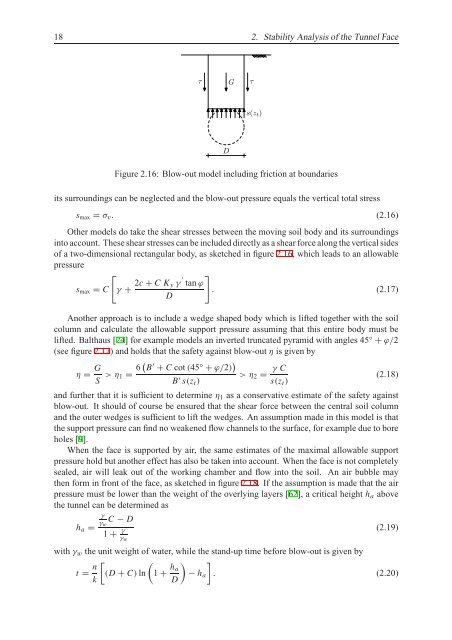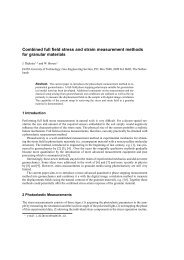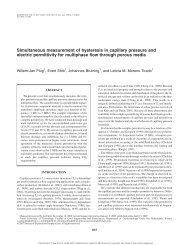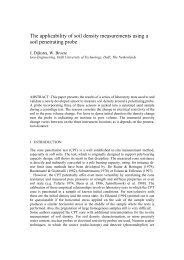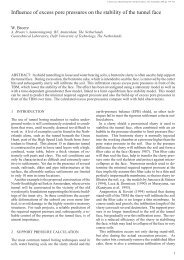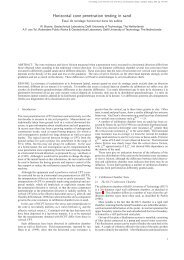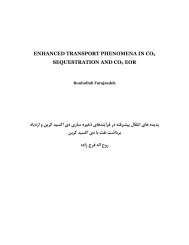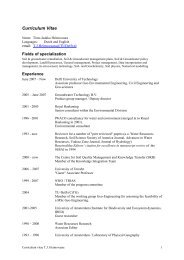- Page 1: Tunnel Face Stability&New CPT Appli
- Page 4 and 5: Dit proefschrift is goedgekeurd doo
- Page 6 and 7: viAcknowledgementsKolla här, min
- Page 8 and 9: viiiAbstractThe tunnel wound on and
- Page 10 and 11: xContents3.2.4 Finite Element Model
- Page 12 and 13: xiiList of Symbols× ij i = j norma
- Page 14: xivList of Symbolsλfirst Lamé con
- Page 17 and 18: 1.2. Outline of this Thesis 3suppor
- Page 19 and 20: Chapter 2Stability Analysis of the
- Page 21 and 22: 2.1. Introduction 7fluidsoilzs Fα
- Page 23 and 24: 2.1. Introduction 9Figure 2.3: Unsu
- Page 25 and 26: 2.1. Introduction 11q sq sq sααα
- Page 27 and 28: φ = 40 ◦φ = 35 ◦2.1. Introduc
- Page 29 and 30: 2.1. Introduction 15T 1 T 1E1 E 1G
- Page 31: 2.1. Introduction 17N Deformation<
- Page 35 and 36: 2.1. Introduction 21Figure 2.19: Ce
- Page 37 and 38: 2.1. Introduction 23Figure 2.21: In
- Page 39 and 40: 2.1. Introduction 25D (m) Soil type
- Page 41 and 42: 2.2. Wedge Stability Model 27the su
- Page 43 and 44: 2.2. Wedge Stability Model 29xyhz =
- Page 45 and 46: 2.2. Wedge Stability Model 31s ′
- Page 47 and 48: 2.2. Wedge Stability Model 33q 02ad
- Page 49 and 50: 2.2. Wedge Stability Model 35200400
- Page 51 and 52: 2.2. Wedge Stability Model 37with a
- Page 53 and 54: 2.2. Wedge Stability Model 39s(z t
- Page 55 and 56: 2.2. Wedge Stability Model 41∆p f
- Page 57 and 58: 2.2. Wedge Stability Model 43has be
- Page 59 and 60: 2.2. Wedge Stability Model 45from t
- Page 61 and 62: 2.2. Wedge Stability Model 47γF(t/
- Page 63 and 64: 2.2. Wedge Stability Model 49s min
- Page 65 and 66: 2.2. Wedge Stability Model 5140∆s
- Page 67 and 68: 2.3. Model Sensitivity Analysis 53P
- Page 69 and 70: 2.3. Model Sensitivity Analysis 55i
- Page 71 and 72: 2.3. Model Sensitivity Analysis 57
- Page 73 and 74: 2.3. Model Sensitivity Analysis 591
- Page 75 and 76: 2.3. Model Sensitivity Analysis 61
- Page 77 and 78: 2.3. Model Sensitivity Analysis 63t
- Page 79 and 80: 2.3. Model Sensitivity Analysis 65o
- Page 81 and 82: 2.4. Comparison with Field Cases 67
- Page 83 and 84:
2.4. Comparison with Field Cases 69
- Page 85 and 86:
Figure 2.57: Overview of soil strat
- Page 87 and 88:
2.4. Comparison with Field Cases 73
- Page 89 and 90:
2.4. Comparison with Field Cases 75
- Page 91 and 92:
2.4. Comparison with Field Cases 77
- Page 93 and 94:
2.4. Comparison with Field Cases 79
- Page 95 and 96:
2.4. Comparison with Field Cases 81
- Page 97 and 98:
2.4. Comparison with Field Cases 83
- Page 99 and 100:
2.4. Comparison with Field Cases 85
- Page 101 and 102:
2.4. Comparison with Field Cases 87
- Page 103 and 104:
2.4. Comparison with Field Cases 89
- Page 105 and 106:
2.4. Comparison with Field Cases 91
- Page 107 and 108:
2.4. Comparison with Field Cases 93
- Page 109 and 110:
2.5. Further Groundwater Influences
- Page 111 and 112:
2.6. Conclusions 97the effective st
- Page 113 and 114:
2.6. Conclusions 99has been made th
- Page 115 and 116:
Chapter 3Horizontal Cone Penetratio
- Page 117 and 118:
3.2. Interpretation of Cone Penetra
- Page 119 and 120:
3.2. Interpretation of Cone Penetra
- Page 121 and 122:
3.2. Interpretation of Cone Penetra
- Page 123 and 124:
3.3. Calibration Chamber Tests on S
- Page 125 and 126:
3.3. Calibration Chamber Tests on S
- Page 127 and 128:
3.3. Calibration Chamber Tests on S
- Page 129 and 130:
3.3. Calibration Chamber Tests on S
- Page 131 and 132:
3.3. Calibration Chamber Tests on S
- Page 133 and 134:
3.3. Calibration Chamber Tests on S
- Page 135 and 136:
3.3. Calibration Chamber Tests on S
- Page 137 and 138:
3.3. Calibration Chamber Tests on S
- Page 139 and 140:
3.3. Calibration Chamber Tests on S
- Page 141 and 142:
3.3. Calibration Chamber Tests on S
- Page 143 and 144:
3.4. Scale Model Tests 129Figure 3.
- Page 145 and 146:
3.4. Scale Model Tests 1315210Figur
- Page 147 and 148:
3.5. Field Tests 133Figure 3.35: Pl
- Page 149 and 150:
3.6. Modelling Horizontal Cone Pene
- Page 151 and 152:
3.6. Modelling Horizontal Cone Pene
- Page 153 and 154:
3.6. Modelling Horizontal Cone Pene
- Page 155 and 156:
3.7. Conclusions 141W H/V 043Ticino
- Page 157 and 158:
Chapter 4High-Speed Piezocone Tests
- Page 159 and 160:
4.2. Determination of Liquefaction
- Page 161 and 162:
4.2. Determination of Liquefaction
- Page 163 and 164:
4.4. Calibration Chamber Tests 149
- Page 165 and 166:
4.4. Calibration Chamber Tests 1518
- Page 167 and 168:
4.4. Calibration Chamber Tests 153v
- Page 169 and 170:
4.4. Calibration Chamber Tests 155-
- Page 171 and 172:
4.5. Conclusions and Recommendation
- Page 173 and 174:
4.5. Conclusions and Recommendation
- Page 175 and 176:
Chapter 5Conclusions and Recommenda
- Page 177 and 178:
5. Conclusions and Recommendations
- Page 179 and 180:
Bibliography[1] M.Y. Abu-Farsakh, G
- Page 181 and 182:
Bibliography 167[30] B. Belter, W.
- Page 183 and 184:
Bibliography 169[65] J.K. van Deen.
- Page 185 and 186:
Bibliography 171[99] E. Kreyszig. A
- Page 187 and 188:
Bibliography 173[133] Committee on
- Page 189 and 190:
Bibliography 175[171] F.W.J. van Vl
- Page 191 and 192:
Curriculum VitaeWout Broere was bor
- Page 193 and 194:
SamenvattingGraaffrontstabiliteit &
- Page 195 and 196:
Samenvatting 181spanningen ook in d
- Page 197 and 198:
NawoordIn de afgelopen jaren heb ik
- Page 199 and 200:
Appendix ABasic Equations of Ground
- Page 201 and 202:
A.1. Semi-confined System of Aquife
- Page 203 and 204:
A.2. Transient Flow 189withS s the
- Page 205 and 206:
....Appendix BBasic Equations of El
- Page 207:
B. Basic Equations of Elasticity 19


